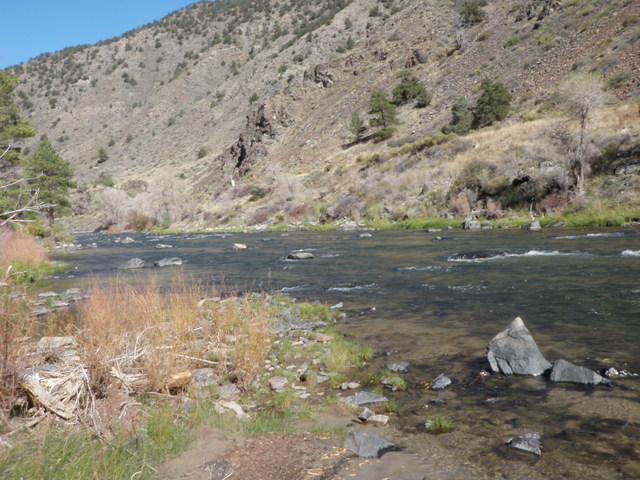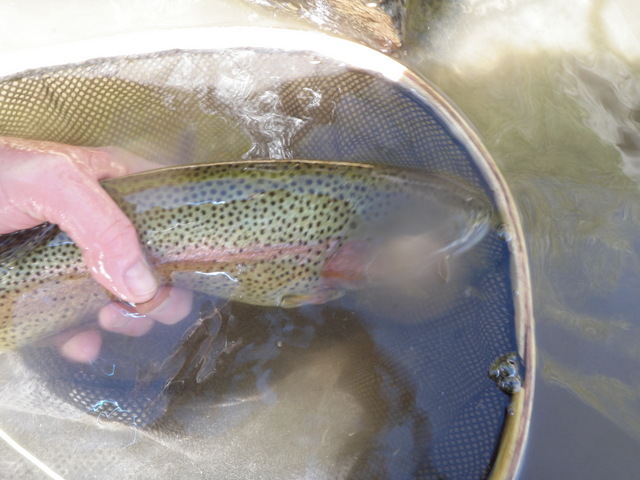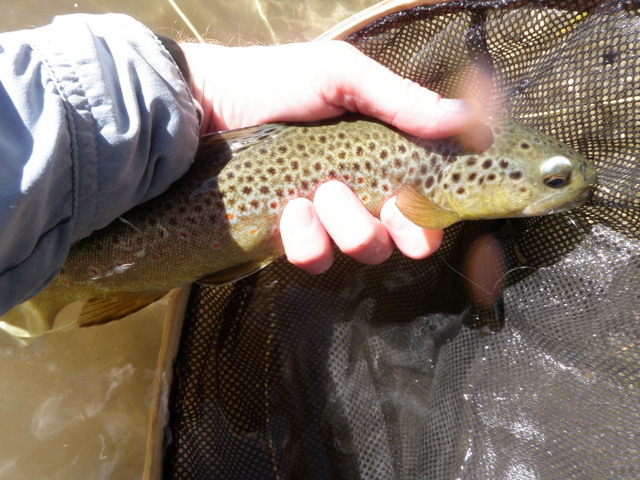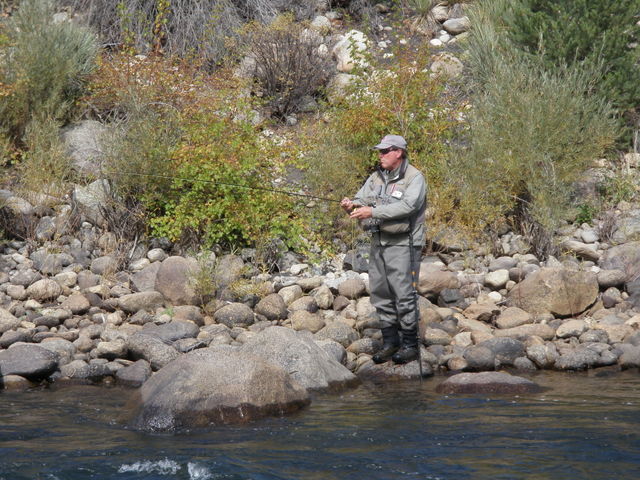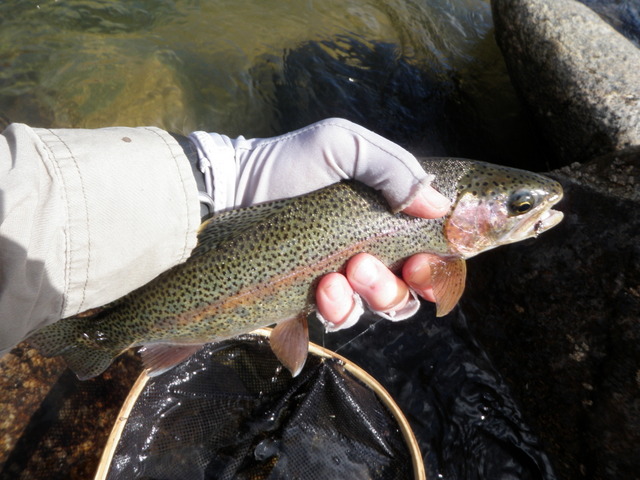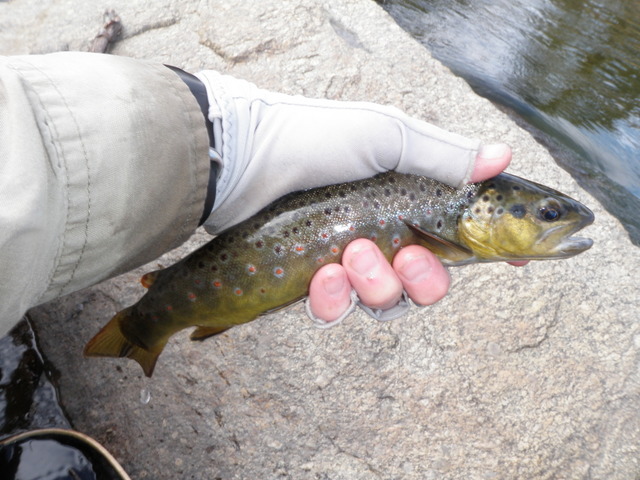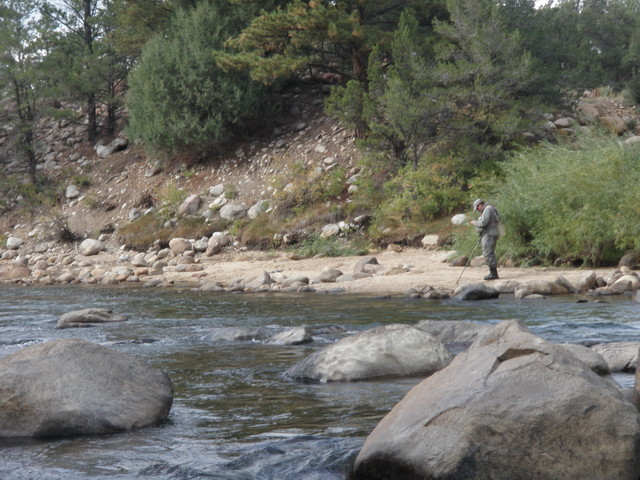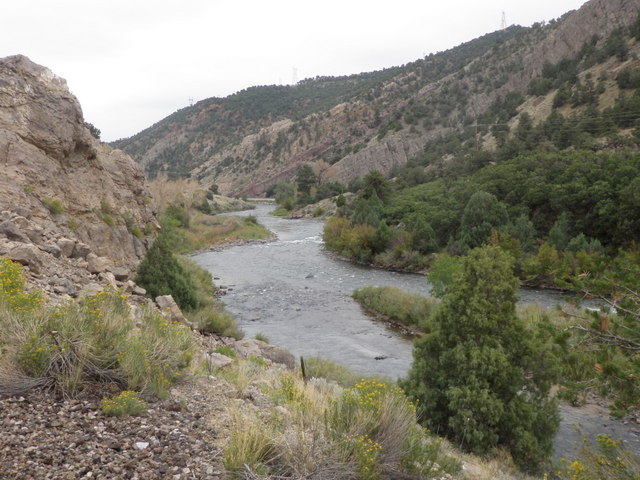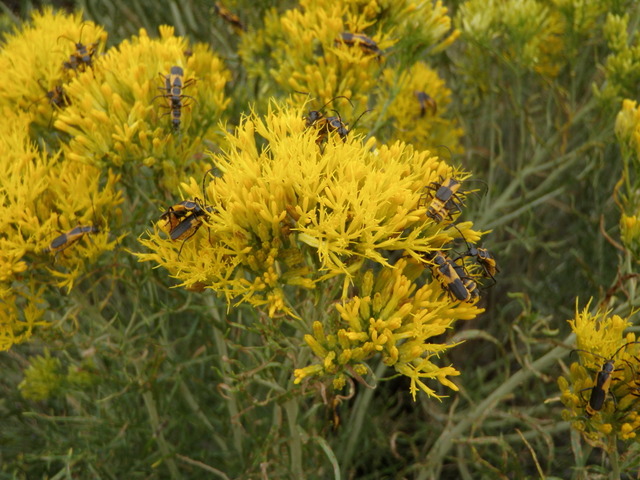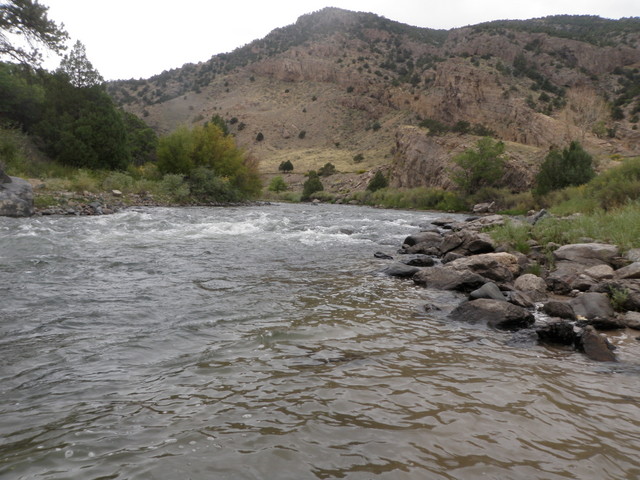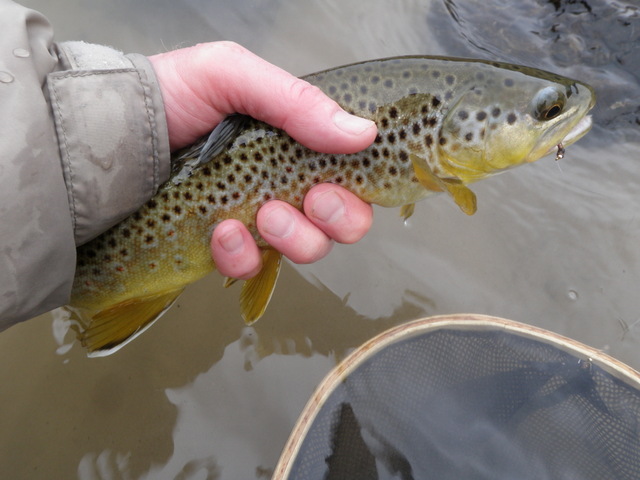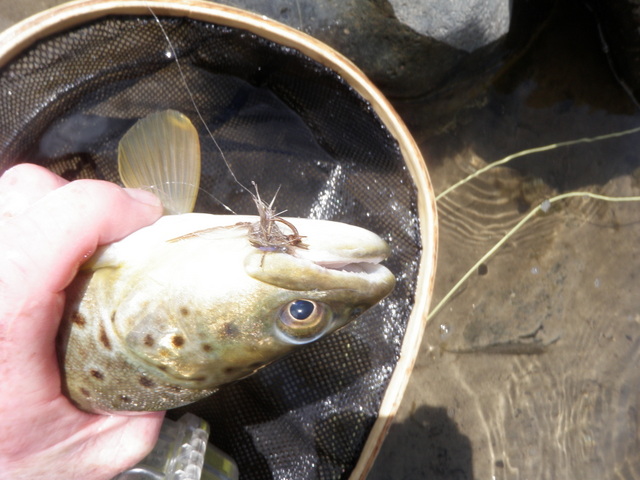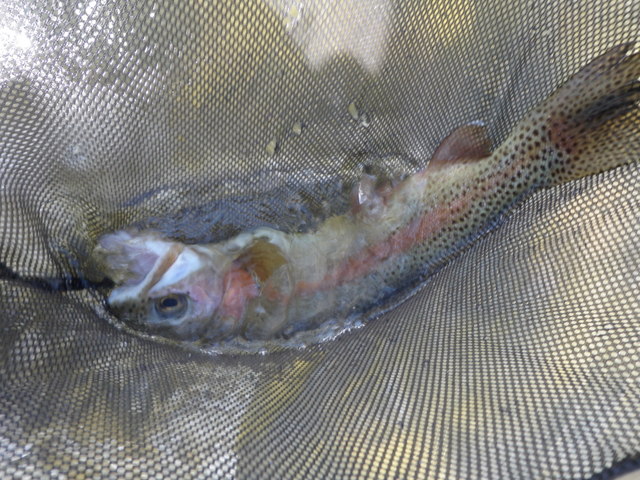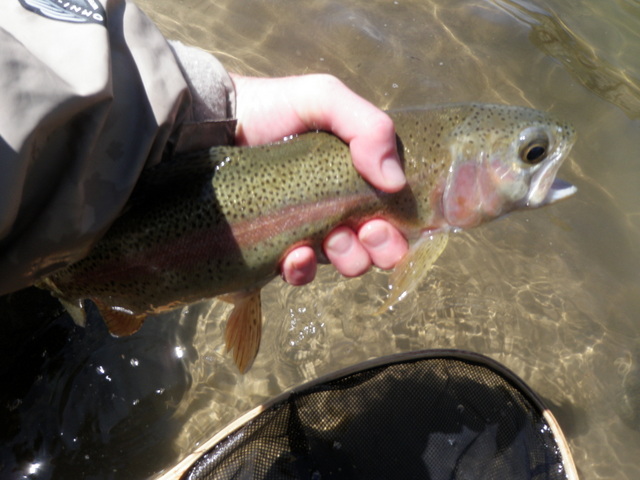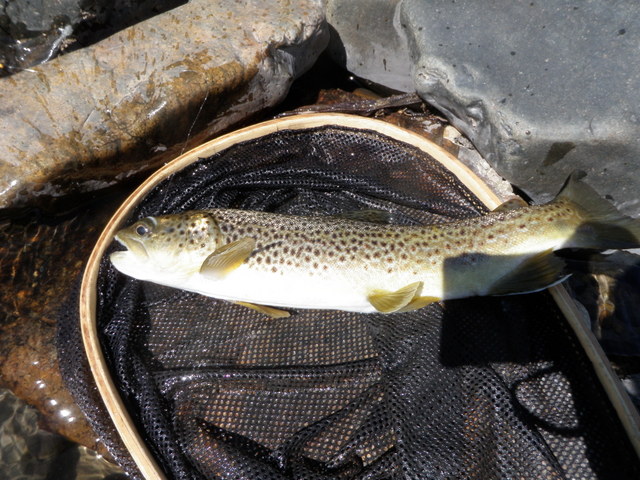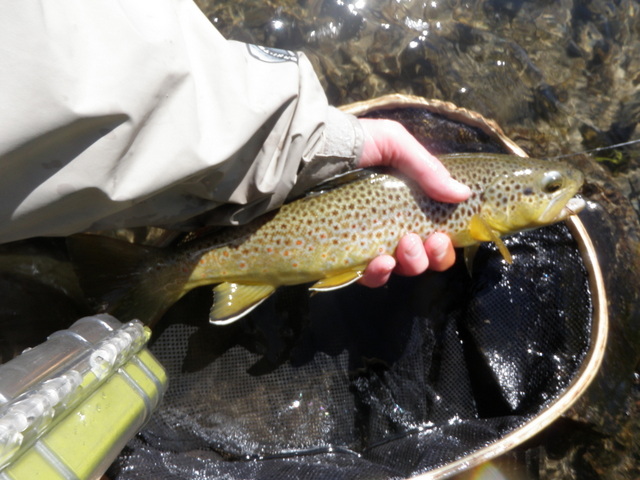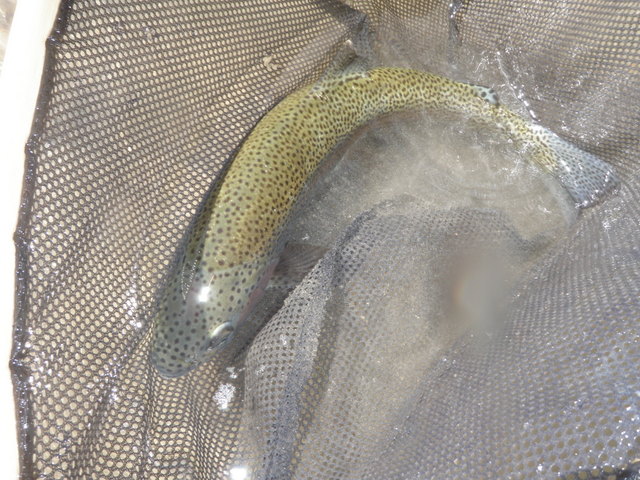Time: 9:30AM – 3:00PM
Location: Fremont – Chafee county line
Fish Landed: 10
Arkansas River 05/01/2015 Photo Album
When we discussed our plans for Friday, Danny decided he wanted retribution for all the lost fish on Thursday and therefore wanted to return to the same place that we fished the previous day. Our plan was locked in, or at least we thought so until I met one of the other young campers at Vallie Bridge. He was wearing a Duke hoodie so I asked him if he was a Duke fan or graduate, and the conversation eventually led to a discussion regarding the whereabouts of the caddis. The young man volunteered that he and his friend were heading downstream toward Texas Creek as some fishermen told them the heaviest hatch was in that locale. Now Danny and I were faced with a dilemma. Should we change our plans to search for the much hyped caddis hatch, or should we return to the Fremont – Chafee county line so Danny could seek vengeance on unsuspecting Arkansas River brown trout?
I suggested that we could spend the morning on a return tour of the Fremont – Chafee area, and then if the fishing was slow, we could make the drive east to Texas Creek in search of the elusive caddis hatch. We packed up all our camping equipment and drove west on route 50 to the Fremont – Chafee county line where we parked and then crossed the river at the tail of the long pool. Once on the north side of the river we ascended the steep bank and hiked down the railroad tracks to the spot below the small island. On Friday we continued farther down along the river and began fishing in a long shelf pool.
I elected to test an old producer; a yellow Letort hopper, and added a beadhead ultra zug bug on a 3.5 foot long dropper. Danny began with a nymphing rig, so I relinquished the deep portion of the pool to him and moved immediately to the narrow top section where the river spilled over some large rocks. In a very short amount of time I foul hooked a brown, and then added two momentary hook ups in two very short marginal pockets along the bank. In the next attractive shelf pool I experienced a refusal, so I began to question my choice of the Letort hopper. It was extremely effective in catching the attention of the trout, but they were turning away at the last instant.
Once again I ceded most of the next pool to Danny and moved to the riffles at the top, but unlike Thursday this area did not produce a fish nor even a refusal. I was eager to approach the right channel around the island, but Danny was still methodically working his way through the pool below me, so I called out that I planned to fish up along the left side of the island and then return when he caught up.
Out of the Net
Top of the Island
In the first small pocket next to the bottom tip of the island I observed yet another refusal to the size 10 hopper. The shape of the hopper is similar to a caddis although ten times larger. Could these fish be drawn to the body shape, but then execute a reversal when they discovered the excessive size? I decided to test my theory and tied on a size 16 olive-brown deer hair caddis. This proved to be a winner, and I landed two medium sized brown trout from pockets along the island until I reached the whitewater at the top, at which point I turned around and walked back to the bottom where Danny was beginning to cast his dry/dropper arrangement. I told him of my success with the size 16 caddis and offered him some of mine.
Danny and I now began to move into the long pool at the bottom of the north channel. Danny’s water looked more attractive than mine, but he was seeking retribution so I relinquished it to him. My side was largely wide shallow slow moving water, whereas, deep runs and pockets screamed big fish all along his side of the river. Sometimes you cannot go by appearances. There were very few caddis in the air particularly when compared to the cloud of small tent wing insects that hovered over the water on Thursday afternoon at the Vallie Bridge lease site. I began tossing long casts to the shallow tail of the pool on the left side and much to my amazement, two fat fourteen inch brown trout rose and confidently sucked in my fly. This was too good to be true. There were no visible caddis on the water, minimal evidence of a hatch in the surrounding bushes, and I was catching nice fish in the less attractive shallow side water.
Danny Ties on a Deer Hair Caddis
As I photographed and released the two brown trout, I certainly caught Danny’s attention. I suggested that he switch from the dry/dropper approach to a single deer hair caddis, and he wandered over to my position to receive two of the ten imitations that were arranged in my front pack. We resumed our casting, and I quickly picked off another fine brown from left side of the current seam that ran down the middle of the pool. Next I moved up five feet or so and made a long cast to the middle portion of the shallow slow moving left side, and once again I was amazed to witness a slow confident slurp of my deer hair caddis. Again this proved to be a solid healthy fifteen inch brown, and I once again snapped some photos.
Very Nice Chunky Brown Trout
Danny meanwhile observed a refusal to his size 16 caddis, and then I nabbed a fifth chunky brown from the center current seam. I could sense that Danny was feeling left out of the fun, so I offered a switch, and he readily accepted my offer. We switched positions, and he resumed the progression up the left side of the north braid, while I crossed to the north bank and began working up along the right side of the center current seam and prospected all the likely deep pockets and runs. The water looked ridiculously delicious, and it did in fact produce two additional nice fish plus one foul hooked escapee, but it paled in comparison to the left portion.
Close Up of the Healthy Brown
While I moved cautiously forward, Danny began to connect with regularity similar to my previous experience. I counted at least five landed fish, and Danny guided one downstream to a point across from me so I could photograph a sixteen or seventeen inch leviathan. I rarely catch fish on the Arkansas in excess of fifteen inches, so this catch was quite noteworthy.
Best Fish of the Trip for Danny
We both now converged at the top of the island, and we decided to use a leap frog strategy to cover the right bank as we moved up the river. It was slightly after noon, so I found a nice grassy spot on the bank and munched my sandwich and carrots, but Danny was still working off his adrenalin rush from the holy water. He wolfed down his sandwich in five minutes and resumed his manic casting and wading.
Unfortunately after lunch the game changed considerably. Since we never saw an abundance of caddis during the red hot action of late morning, I can only assume that the bright sun and warmer temperatures caused the fish to become lethargic and less interested in snatching our deer hair caddis from the surface. We moved upstream through some attractive areas, but neither of us were able to resurrect our morning success.
Focused
When we reached our crossing point, we debated returning to the car to seek another location, but I saw some large gray clouds building in the west, so I guessed that the action might improve if we continued on the north bank toward the west. I was familiar with this water, and I knew there were some very productive stretches ahead of us. Danny agreed with my suggestion, and we continued on, but my theory did not prove out. Danny’s confidence sank and there were several periods where he sat down and rested and watched me.
When the fish ceased showing interest in my size 16 caddis after lunch, I switched to a dry/dropper configuration with a Charlie boy hopper, beadhead ultra zug bug and beadhead hares ear, and these flies remained on my line for the remainder of the day. During one of the time slots when Danny watched and rested, I lobbed a backhand cast to a deep run behind a large boulder, and as we both looked on, a mouth appeared and engulfed the Charlie boy. I set the hook and an underwater missile rocketed downstream. I applied pressure as best I could but in short order the fish broke off all my flies, and I reeled up a vacant tapered leader. This bit of excitement provoked Danny to resume casting.
Long Slender Rainbow
Finally after several hours of fruitless casting, I approached a juicy section of the river consisting of large submerged and protruding boulders with nice deep pockets and runs flowing around the current breaks. Normally I view this type of water as prime brown trout habitat, but on Friday the browns seemed to be spread out in shallow riffles and next to the bank. Sure enough as the Charlie boy drifted down along a current seam, it took a dip and I set the hook and fought a spirited fish. When I slid my net beneath the rugged fighter, I discovered a seventeen inch rainbow. I was proud to make this my tenth catch of the day, and the long slender rainbow gave me a temporary boost in confidence.
I convinced Danny to make one more forward leap, so we ascended the steep bank and walked west along the railroad tracks for another 100 yards and then descended to some nice shallow runs and riffles, where we split the sections. I fished my way upstream once again and finally after twenty minutes without success, a fish emerged near my Charlie boy. I set the hook, but either I was premature or the fish refused my fly, and this resulted in another foul hooked incident. The fish got free before I netted it, but the tussle created a huge tangle of all my flies, so I used this as an excuse to call it a day and waded back downstream until I found Danny.
Did we succeed in finding the elusive Arkansas River spring caddis hatch? When compared to several of the exciting experiences of my past when caddis blanketed the river and crawled into every available nook of my physical person, the answer is no. But for two hours on Friday morning, the brown trout in the area of the Arkansas River where we were fishing were feasting on our deer hair caddis with reckless abandon. It may not have been the core caddis emergence, but it was an incredible period of fast action, and we were rewarded with nice fish in the 13 – 17 inch range. No complaints will be voiced by Dave and Danny.

